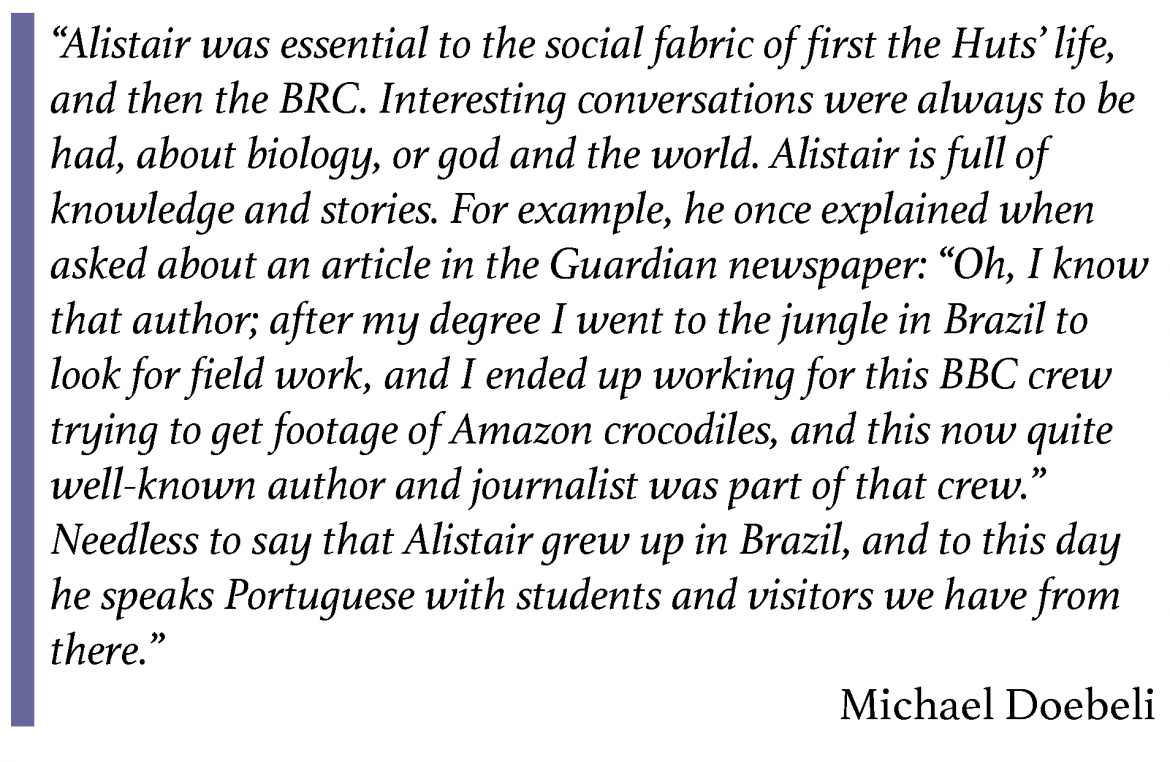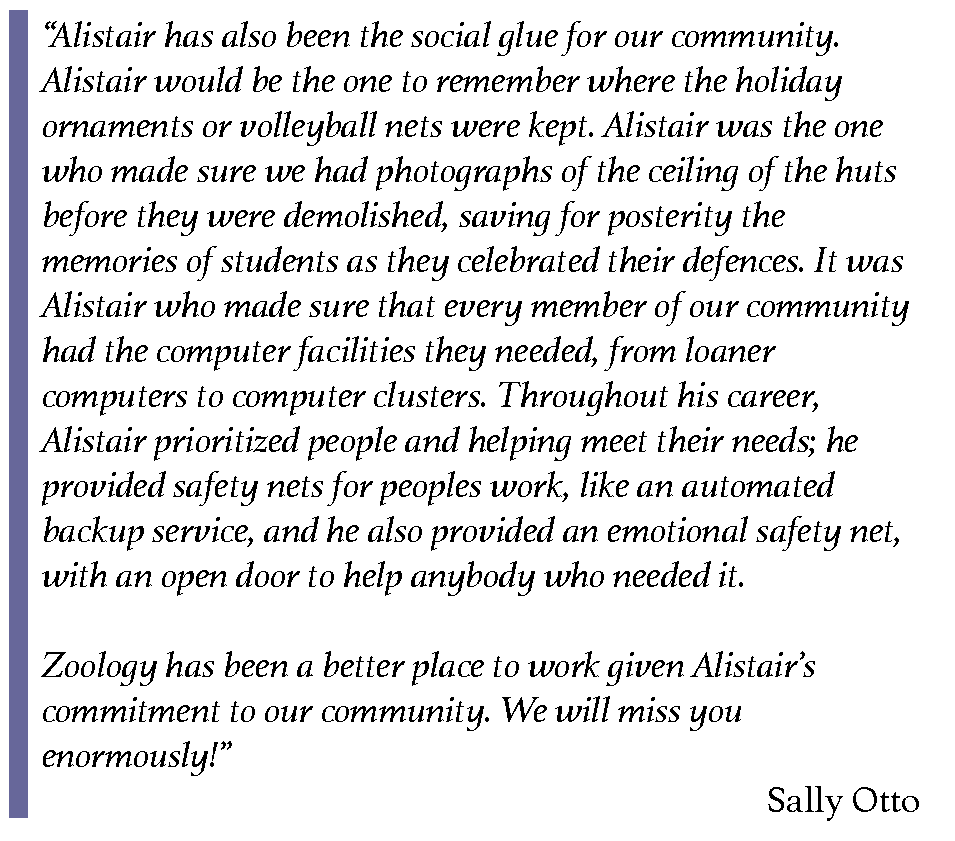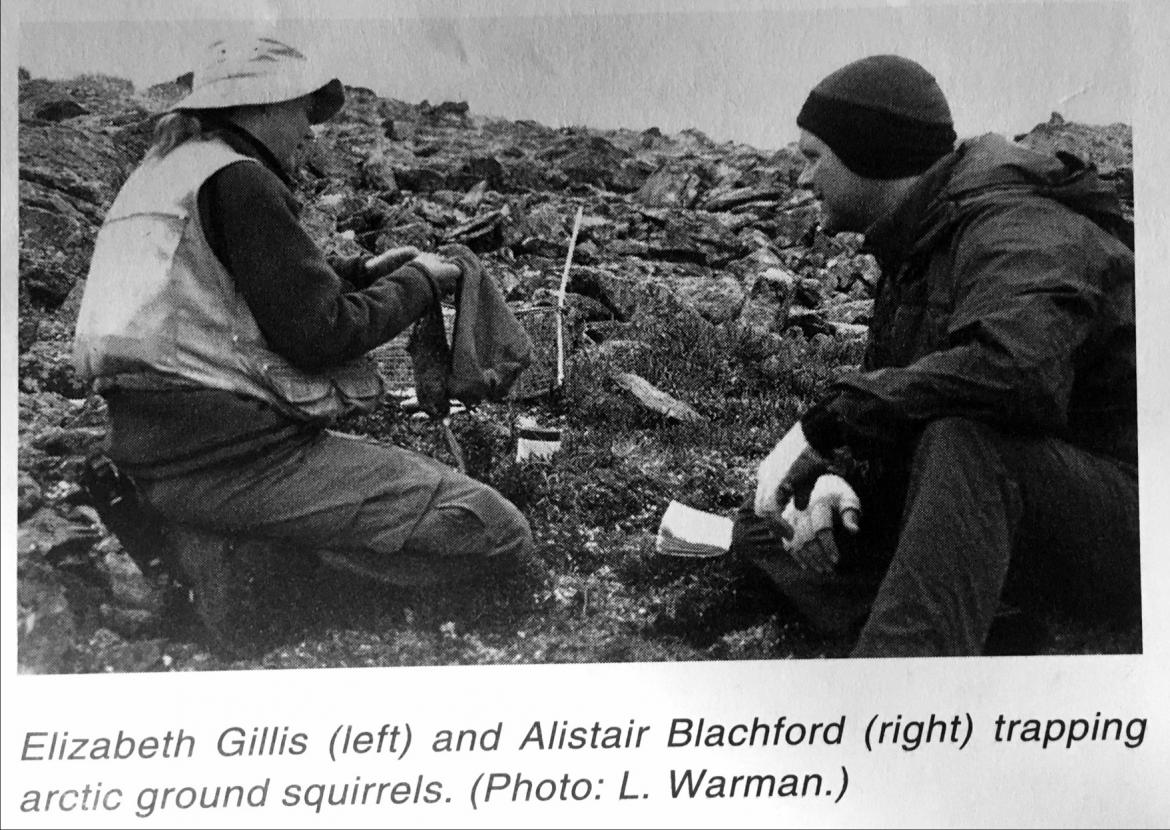
Dr. Alistair Blachford is retiring after decades of being an integral member of the Department of Zoology and the Biodiversity Research Centre. As the manager of the Zoology Computing Unit (ZCU), and, as member of the community, Alistair brought both biological and technical expertise. "That he was always studying something himself, he could relate personally to our experience - - scientists wondering how to do things” adds Lee Gass.
After completing his BSc (Honours) in Biology, Alistair began preparing to do an MSc in Computer Science. During that time, he also helped create an environmental section in an engineering company and realized that he wanted to stay in biology. He turned down an offer for a masters in engineering at Waterloo and came to UBC instead. He did an MSc with Carl Walters at the Institute of Animal Resource Ecology (IARE) in the fall of 1980. That was his first post to the Huts!

In the early 1980s, the available computing resources were consolidated in the Biosciences Data Centre (BDC), and were kept running by three student "elves" paid in part as teaching assistants. Alistair gladly accepted an elf position and kept a single "big" computer running, first a PDP-11/45 and later a VAX 11/750.
|
“Thinking back on the way it was on that first machine, to say that they “kept the system going” far, far underestimates what they managed to push out of that machine. Plotter, printer, magnetic tapes, real core memory in the back. I don’t know how many terminals there were (at least a dozen). The ecological community kept that CPU bouncing all around the world. With elf Bill Webb’s (name slipped my mind) we wrote theses and papers, programmed publication-quality graphics, wrote and ran models, ran real-time modelling courses and workshops. Statistical programs, modeling platforms, Unix environment... The computing environment in the huts was pretty hot back then, and the elves kept it near the limit. Here’s one small example of something Alistair did back then. My student Staffan Tamm studied hummingbirds in a small valley in the south Okanagan, and he and Alistair programmed a little computer as a field data recording system. Every night, Staffan drove down to the nearest pay phone, connected with the 11/45, downloaded his data for the day, and launched a set of analyses he picked up the next night. As far as we knew, nobody had done that kind of thing, it was fraught with all kinds of worries about all the connections, but they made it work. That’s how I think of Alistair in the Data Centre: Collaborator. That’s how it always felt to me, and I think that’s what it was. He didn’t just do things for us. Especially when they were hard things, he did them with us. Given the prodigious intellectual and technical gifts he brought to the table, collaborations with Alistair at whatever scale were always productive. Whenever that happened in anyone’s lab, everyone knew about it. Alistair had plenty of that kind of business. Fortunately, he’s a good teacher and people wised up fast. He wrote manuals on all sorts of things, compiled them into banks of flip-through documents on almost everything. The courses he taught saved everyone’s time. That vast informational infrastructure freed Alistair to collaborate on the interesting stuff. He also had plenty of that kind of fun.” |

As BDC grew in scope it became clear that a full-time staff member was needed. The first elf to graduate got the job so Alistair officially started in 1985. In the early days, he was mainly a consultant, helping line people up with appropriate methods for data acquisition, exploration, analysis and presentation, as well as programming custom solutions. This kept Alistair in touch with lots of cool biology projects. He got to meet the raccoon and other under-hut wildlife while wiring the Huts for ethernet (even a hut-to-hut underground span). Among other things, he set up email before central IT offered it, and rigged a DOS-running PC at the research station in Kluane to be a multi-user email send/receive station to save long distance phone charges.
| “The role of computers in biology has transformed since 1985 when Alistair launched the Zoology Computing Unit. Over these years, Alistair has saved us all countless hours of frustration and work, from rescuing students’ lost data, to troubleshooting software bugs, to suggesting appropriate computational solutions to teaching and research problems. By Sally Otto” |
The exciting and free-wheeling times of the BDC came to end and by 1991, Alistair was the sole remaining staff member in 1991 because he was the only position entirely paid by Zoology. Geoff Scudder was Head at the time and he saved the remains by forming the Zoology Computing Unit (ZCU). The staff levels waxed and waned over the next few years and at times, Alistair ran the ZCU solo, performing help desk, sysadmin, and managerial duties. It was during one of these periods that he transitioned us from terminal/VAX to client/server architecture.

|
“In 1990’s UBC had made the deliberate decision to decentralize computing services. Funding that had previously gone to central IT was distributed instead to faculties. By 2010 there was a strong trend in the other direction, toward the centralization of computing services. Some other universities, and some other faculties at UBC, had already started to centralize. In late 2012, Dean Peacock requested a study of IT service delivery within the Faculty of Science. Alistair served on the eight member Faculty of Science IT review panel. The Group gathered information in numerous ways including an online survey. Among the questions in the survey was a request to rate the level of satisfaction across 13 IT service categories. Due to Alistair’s’ determination to always provide the very best quality of service and support to his users the ZCU scored the highest (4.89/5) across all departments in Response Time, Customer Service, Staff Knowledge and Successful Resolution During the review Alistair lobbied vehemently that a distributed or “embedded IT" model is much better than a centralized one at reducing the overheads experienced by researchers and instructors and the most effective way to support their needs. Throughout the review he voiced his concerns about the folly of IT centralization and backed them up with research that was central to the report for the Dean. Ultimately the Dean agreed that local IT was integral to the success of researchers, staff and students in the Faculty of Science and the Faculty of Science IT Managers group was formed, which Alistair continues to participate in. Throughout his career Alistair has always voiced his opinions about how things could be done better and then follow them up with detailed logic that was hard to ignore. When the plans for the Bio Science Complex were initially released, Alistair was the only person to point out that it did not include a server room. He passionately voiced his concerns that a server room was key to the support of research and teaching in Biosciences and extremely short sighted to not be included in a Science building. The Dean approved the addition but in 2015 the Bio Science building design team threatened to remove the server room as a way to reduce the size and scope of the project to meet the budget. Simultaneously, UBC IT were flaunting the merits of The University Data Centre (UDC) and campaigning to not have local server rooms. Despite the strong opposition, Alistair successfully made the case for the localized server room out of concern for the safety and security of individual research servers residing in offices and closets without back-up or cooling, the need for proximity in a field where computers are not just support for but an integral player in research experiments, and the potential increase in data processing required to support teaching. Alistair went on to design the layout of the room and prior to the completion of the building Alistair sourced second hand racks, chillers and UPS saving the Faculty of Science over $100K. He also secured free storage for the equipment for eighteen months while he waited for the building to be completed. The Botany, Micro Biology and Zoology departments will benefit for years to come thanks to Alistair’s’ efforts. Alistair has been an advocate for the quality of IT support and service for nearly 38 years. He voiced his opinions to ensure faculty, staff and students got the support they needed to do their jobs effectively. He often challenged convention but was always quick to back up his conviction with well researched facts. Over the years he has made many of us look at solutions from different directions. His quick mind, integrity, quirky way of thinking, fun facts and stubbornness will be missed.” |

Alistair also had broader roles in UBC information technology. He taught UNIX through UBC's Continuing Studies for over two decades (1987-2008). In the early 2000's, he pounced on the opportunity to get better computing space and equipment and wrote the "Biodiversity Information Processing Laboratory" part of the Biodiversity CFI proposal. At the time, a half-terabyte storage area network cost $60,000! In 2013, he served on an advisory committee to Dean Simon Peacock to help frame FOS policies for Information Technology.
Coupled with his expertise in IT, Alistair maintained a passion for biology. In the early years of the ZCU, this was nurtured off hours by sea kayaking all over the west coast, and some in the arctic, as well as through environmental activism. He more formally came back to Biology by doing a PhD with Michael Doebeli while also starting a family, all while continuing as the ZCU manager.
|
“Alistair wrote a first-class Ph.D. thesis on the ideas that arose from Dennis Chitty’s studies of vole population dynamics. In the decline phase of their cycles voles reduce their reproductive rate, the exact opposite what theory predicted for animals about to die. He showed in simulations that indeed the conventional theory was wrong, and voles were smarter than we thought. Some theoreticians were unhappy with his work and prevented it from publication, not something we were happy with in Zoology. From 2008-2010 we were able to work on Herschel Island for the International Geophysical Year to study the lemming cycles Alistair had written about in his thesis. He came north to assist, and was a great help to us in snowy owl radio-tagging, lemming trapping, and coping with the arctic summer in the far North on Herschel Island. Alistair’s ever-humming brain was a great attractant for the surging mosquitoes. He embraced the extremes of the north with relish, including a midnight skinny-dip in the Beaufort Sea, still harbouring many ice pans at the summer solstice. In 2007, upon seeing a group of female eider ducks who had lost their clutches, he commiserated with other male staff who agreed that the ducks must be happy with their freedom. The following year, when a storm surge flooded the nests of eiders and shorebirds close to camp, Alistair’s reaction was quite different. He collected many of the flooded eggs in his shirt pocket to try and keep them warm until the sea receded. The “a-ha” moment was learning, soon after, that Alistair was about to enter parenthood, as his wife, down south, was pregnant. Alistair was always there for we retired folks when our computers outwitted us, and he always had with Andy and Richard’s help a fix to move research forward. In the real world we would have given him a Nobel Prize, or at least a UBC Nobel Prize for his support." |
